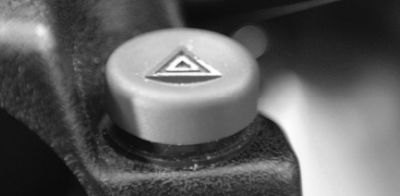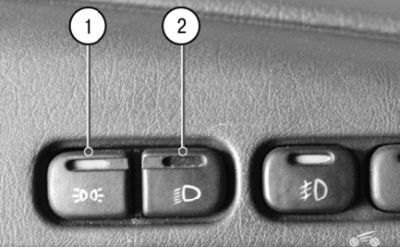
1.7. Instrument panel and controls
On the dashboard (pic. 1.7) the following controls are located. 1 - switch lever for direction indicators and headlights. 2 – a nozzle of an obduv of glass of a forward door. 3- instrument cluster. 4 - steering wheel. 5 - switch of sound signals.

Hazard switch
6 - alarm switch. When the button is pressed, the flashing light of all direction indicators and the indicator lamp in the instrument cluster is turned on. Pressing the button again turns off the alarm:
7 - switch (lock) ignition (pic. 1.8), integrated with the anti-theft device, is located on the right side of the steering column. The key in the lock can take one of three positions:
- 0 – «turned off». All consumers are off, the key is removed. When the key is removed, the locking mechanism of the anti-theft device is activated. To securely lock the steering shaft, turn the steering wheel to the right or left until it clicks. To turn off the anti-theft device, you need to insert the key into the ignition switch and, slightly turning the steering wheel to the right and left, turn the key to the position «I»;
- I – «ignition». The ignition is on, the key cannot be removed, the steering is unlocked;
- II – «starter». The key cannot be removed, the steering is unlocked. It is achieved by turning the key clockwise against the force of the spring. In this position, the key is not fixed - for the starter to work, it must be held by hand. The ignition switch is equipped with a starter engagement lock when the engine is running. To restart the starter after an unsuccessful attempt to start, move the key from the position «I» into position «0», and then back to position «II».

1.8. Switch (lock) ignition
Warning! Do not turn off the ignition or remove the key from the lock while driving - the steering will be blocked and the car will become uncontrollable.
8 - switch lever for wipers and windshield washer.
9 - the immobilizer signaling sensor is installed on a car with a fuel injection system equipped with an electronic anti-theft system, and is designed to transfer the secret code from the working code key through the immobilizer unit to the engine control controller.
10 - a block of signal lamps of the onboard control system. The following lamps are installed in the unit (pic. 1.9):
1 - signal lamp for an emergency drop in the oil level in the crankcase. Lights up in orange if the oil level in the crankcase has dropped below the mark «MIN» pointer;
2 - signal lamp of insufficient fluid level in the windshield washer reservoir. Lights up in orange if there is less than 1 liter of washer fluid left in the tank;
3 - signal lamp of insufficient coolant level in the expansion tank. Lights up in orange when the coolant level on a cold engine drops below the allowable limit;

1.9. Block of signal lamps of the onboard control system
Notes. Before adding oil to the engine check if it is leaking due to a leak in the engine lubrication system. Before adding liquid, check the tightness of the engine cooling system.
4 - signal lamp for open doors. Lights up red when the car door is not closed;
5 - signal lamp for a malfunction of the stop lamp or parking lights. Lights up red in case of a brake lamp malfunction when the brake pedal is pressed or any side light lamp when it is turned on;
6 – signal lamp of wear of overlays front brake pads. Lights up in orange when you press the brake pedal and stays on until the ignition is turned off if the thickness of the front brake pads has decreased to 1.5 mm;
7 – a signal lamp of not fastened seat belts. Lights up red when the driver's seat belts are not fastened.

11 - outdoor lighting switch
11 - outdoor lighting switch. The switch block contains two mechanically linked switches:
- side light switch 1. By sequentially pressing the switch key, the side light in the headlights and rear lights is turned on and off; when the side light is on, the control lamp with a green light filter in the key lights up;
- headlight switch 2. When you press the switch button (fixed position) headlights turn on. Pressing the button again turns off the headlights.
Note. The mechanical connection of both switches excludes the possibility of turning on the headlights without first turning on the side lights and, conversely, does not allow turning off the side lights when the headlights are on.

12 - block of key switches
12 - block of key switches include the following:
- switch 1 front fog lamps. The fog lights are turned on by pressing the switch button while the side light switch button is pressed, the control lamp in the button lights up at the same time. Pressing the button again turns off the fog lights;
- switch for 2 rear fog lights. Pressing the switch button turns on the rear fog lights if the outside lights are on. Pressing the button again turns off the rear fog lights;
- switch 3 for heating the glass of the tailgate. When the switch button is pressed, the glass heating is switched on, at the same time the control lamp in the button lights up. Pressing the button again turns off the heating.

13 - trip computer
13 – trip computer, installed on a part of manufactured cars, is designed to measure, accumulate and display one of the following parameters on a digital display:
- current fuel consumption;
- average total fuel consumption;
- average speed of movement;
- the distance traveled;
- current time;
- travel time.
14 - plug.
15 – a control lamp of antiblocking system (ABS) brakes. It is installed instead of a plug if the car is equipped with an anti-lock braking system.
16 – a control lamp of a condition of an airbag. Installed in place of the plug if the vehicle is equipped with an airbag.
17 - central nozzles of the ventilation and heating system.
18 – a cover of the top ware box. To access the upper glove box with the lower glove box lid open, press the top cover lock lever.
Note. The lock lever is located in the upper part of the niche of the lower glove box.
19 - side nozzle of the ventilation and interior heating system.
20 - cover of the lower glove box. to open it, press the handle of the locks against the handle. If the exterior lighting is on, a special lamp illuminates the inside of the glove box.
21 - magazine shelf.
22 - control panel for the ventilation and heating system.
23 - socket for radio equipment. Installation of radio equipment is provided, corresponding in size and method of fastening to international standards.
24 - front ashtray.

25 - switch for heating the right front seat.
25 - switch for heating the right front seat.
26 - switch for heating the left front seat.

27 - parking brake lever.
27 - parking brake lever. To brake the car with the parking brake, lift lever 2 all the way up - the red indicator lamp in the instrument cluster will light up. to brake the car, pull the lever up a little, press button 1 on the end of the lever handle and lower it all the way down - the control lamp should go out.
28 - gear lever.

29 - cigarette lighter
29 - cigarette lighter. To use the cigarette lighter, press the cartridge until it locks and release. After about 20 seconds, the cartridge automatically returns to its original position, ready for use.
30 - heater electric fan switch.
31 - accelerator pedal.
32 - brake pedal.
33 - clutch pedal.
34 - handle for adjusting the angle of the steering column.

35 - instrument lighting switch
35 - light switch dashboard. Rotate the knob to adjust the brightness of instrument lighting and switch backlights, if outdoor lighting is on.

36 - headlight hydraulic corrector control knob
36 - headlight hydraulic corrector control knob. By turning the knob, adjust the angle of the headlight beam in such a way as to prevent dazzling oncoming drivers. The positions of the hydraulic corrector handle correspond to the following vehicle loading options:
- 0 - one driver;
- 1 - all seats are occupied;
- 2 - all seats are occupied and cargo is in the luggage compartment;
- 3 - one driver and cargo in the luggage compartment.
- 37 - hood lock drive lever.
- 38 - socket for connecting a portable lamp.
